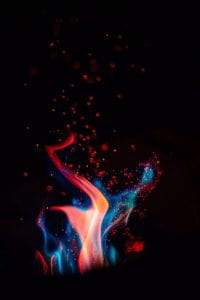 On June 4, 1623, Pentecost Sunday, Louise de Marillac experienced a transformation in her life. She would later write, “On the Feast of Pentecost, during holy Mass or while I was praying in the church, my mind was instantly freed of all doubt.” (i) Louise’s doubt disappeared in a powerful mystical experience that she would call her lumière, or light. She had a vision of her future, in which she lived the life she had always wanted, serving the poor as a member of a religious community. Her current hardships would not last forever, and her newfound certainty would give her the strength to persevere.
On June 4, 1623, Pentecost Sunday, Louise de Marillac experienced a transformation in her life. She would later write, “On the Feast of Pentecost, during holy Mass or while I was praying in the church, my mind was instantly freed of all doubt.” (i) Louise’s doubt disappeared in a powerful mystical experience that she would call her lumière, or light. She had a vision of her future, in which she lived the life she had always wanted, serving the poor as a member of a religious community. Her current hardships would not last forever, and her newfound certainty would give her the strength to persevere.
When I read stories of saints and holy people, I envy the turning points that are often part of this genre. Imagine: All at once, you know what you are meant to do with your life! You are gripped with conviction, freed from insecurity and uncertainty, and fortified by a singular, powerful purpose. Vincent de Paul experienced such a moment when he realized his calling to serve the French peasants. Oscar Romero did too, when the assassination of his friend Rutilio Grande called him to criticize the oppressive Salvadoran government. Perhaps most famously, Saint Paul experienced such a moment on the road to Damascus, when a light from the heavens knocked him to the ground. In the Christian tradition, these can be called moments of conversion.
Maybe you’ve experienced a sudden certainty or conviction that changed your life. Personally, I haven’t. Unlike Louise, I’ve never seen my future in a flash of light. My life changes gradually, more like a cycle of sunrises and sunsets. The sun doesn’t just appear at its high-noon zenith. First, the sky fades from black to gray, and then the sun peeks over the horizon. It climbs slowly, serenely, and the day unfolds. If I’m lucky, each day illuminates some small truth for me, helping me understand myself and the world just a bit better. And then the sun sets.
While I long for Louise’s certainty, she also put up with a lot of unhappiness along the way. Her lumière vision told her that she needed to stay put for the time being. Despite the “spiritual anguish” she felt over her husband’s deteriorating health and difficulties with her son, she continued to accept her spiritual director’s calming advice, and bore with her marriage even though she longed for something more and suffered through depression.(ii) Her lumière showed her the way, but it didn’t eliminate the sorrows, the headaches, the day-to-day drudgery that we all experience. When I think about her lumière that way, it becomes a lot more relatable. She had a vision, but her life still had to unfold, and that took time.
The Feast of Pentecost is commemorated fifty days after Easter. According to scripture, the Holy Spirit came down upon Jesus’s apostles and Mary, his mother. We often see them depicted with tongues of fire floating above their heads, representing the spirit within them. You have to remember that this community was heartbroken; just fifty days earlier, their beloved friend and community-member had been tortured and killed on the cross. This traumatic event surely took a toll on their bodies and spirits. It was in the midst of this mourning that God appeared to them in another form, coming down upon them in flame. This fire fueled them to continue Jesus’s mission, to spread his teachings, and to keep building their community.
This is the story that Louise would’ve been reflecting on when she had her vision. Her lumière was a Pentecost moment, a moment of God’s sudden, surprising presence in a time of sorrow. Like the apostles, she found the strength to continue. And like the apostles, she still had to deal with pain and suffering as she worked to realize her vision. Her transformation was both sudden and slow.
As we remember Louise’s lumière over 400 years later, let us open ourselves to the presence of a higher power within and among us—in all of God’s many forms. Let us experience the slowness of daybreak and a fire that emerges from within each one of us. Let us be patient with ourselves—and let us be agents of our own transformation.
Reflection Questions:
- Have you ever experienced a sudden turning point like Louise’s lumière?
- How have you experienced God’s presence in the ordinary moments of your life?
Reflection by: Abigail Rampone, Ministry Coordinator for Vincentian Service and Immersions
———————————————————————————————————————–
i A.2 “Light,” The Spiritual Writings of Louise de Marillac, ed. and trans. Louise Sullivan, D.C. (New York: New City Press, 1991), 1. Available at: https://via.library.depaul.edu/ldm/11/.
ii See Kieran Kneaves, D.C., “A Woman Named Louise: 1591–1633,” Vincentian Heritage 12:2 (1991): 126. Available at: https://via.library.depaul.edu/vhj/vol12/iss2/3/.